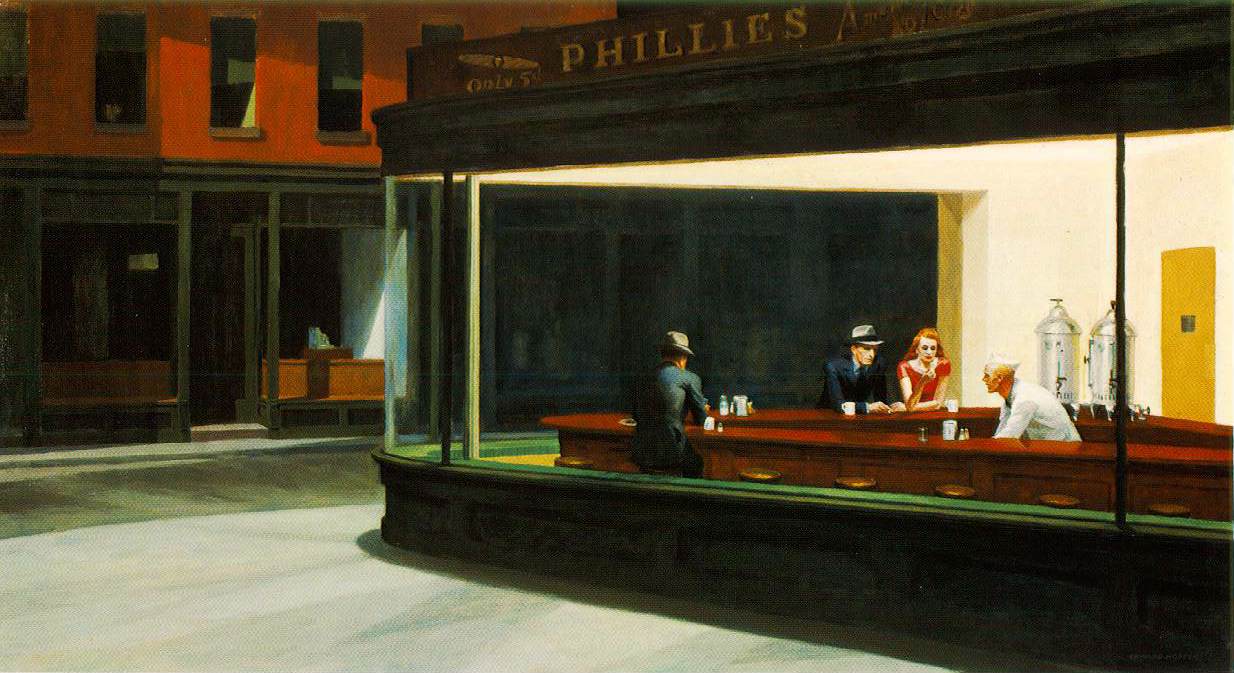Edward Hopper (1882–1967), 1941 or 1942. Fabricated chalk and charcoal on paper; 11 1/8 x 15 in. (28.3 x 38.1 cm) Whitney Museum of American Art, New York; purchase and gift of Josephine N. Hopper by exchange 2011.65 © Heirs of Josephine N. Hopper, licensed by the Whitney Museum of American Art, New York

Another Study for Nighthawks
Nighthawks (from the Art Institute of Chicago)
This spring, the Whitney Museum celebrates Edward Hopper’s achievements as a draftsman in the first major museum exhibition to focus on the artist’s drawings and working process.

Studies for Summertime

Summertime
Monograph/Catalogue

Along with many of his most iconic paintings, the exhibition, Hopper Drawing: A Painter’s Process is accompanied by a full-color, scholarly monograph, written by exhibition curator Carter Foster, the Whitney Museum of American Art’s curator of drawings, with contributions by Mark Turner and Nicholas Robbins, published in association with Yale University Press. The catalogue features groundbreaking research into the subjects of Hopper’s paintings, including new archival and photographic research. features more than 200 drawings, the most extensive presentation to date of Hopper’s achievement in this medium, pairing suites of preparatory studies and related works with such major oil paintings as New York Movie (1939), Office at Night (1940), Nighthawks (1942) and Morning in a City (1944).

Study for South Carolina Morning Charcoal on paper 8 1/2 x 11 inches 1955
South Carolina Morning, 1955
The show will be presented from May 23 to October 6, before traveling to the Dallas Museum of Art from November 17, 2013 to February 6, 2014 and the Walker Art Center from March 15 to June 22, 2014.
Edward Hopper study drawing for Morning Sun (1952) with numerous value notes

Edward Hopper Morning Sun (1952)
Culled from the Museum’s unparalleled collection of the artist’s work, and complemented by key loans, the show illuminates how the artist transformed ordinary subjects—an open road, a city street, an office space, a house, a bedroom—into extraordinary images. Carter E. Foster, the Steven and Ann Ames Curator of Drawing at the Whitney, organized the show based on his indepth research into the more than 2,500 works on paper by Hopper in the Whitney’s collection.

Edward Hopper Study for Cape Cod Evening
Cape Cod Evening (National Gallery)
These pieces trace the artist’s process of observation, reflection, and invention that was central to the development of his poetic and famously uncanny paintings. The works on view will span the artist’s career, from early drawn exercises of his student days to Sun in an Empty Room (1963, private collection), one of the last paintings Hopper completed, and are concentrated on midcentury sheets related to his best-known oil paintings.

Edward Hopper Study for Rooms by the Sea, 1951

Edward Hopper Rooms by the Sea, 1951
“By comparing related studies to paintings, we can see the evolution of specific ideas as the artist combined, through drawing, his observations of the world with his imagination,” says Mr. Foster. “In other instances, his drawings provide a crucial form of continuity among thematically related paintings, a kind of connective tissue that allowed Hopper to revisit and re-examine ideas over time.”

Study for “Office at Night” (1940)/Courtesy the Whitney Museum.

Edward Hopper (1882–1967), Study for Office at Night, 1940. Fabricated chalk and charcoal on paper, 15 1/16 × 19 5/8in. (38.3 × 49.8 cm). Whitney Museum of American Art, New York; Josephine N. Hopper Bequest 70.340
Office at Night (Walker Art Center)
While exhibitions and scholarly publications have investigated many aspects of Hopper’s art— his prints, his illustrations, his influence on contemporary art, to name a few—this exhibition will, for the first time, illuminate the centrality of drawing to Hopper’s work and allow a fresh look at his landmark contributions to twentieth-century art. His drawings help to untangle the complex relationship between reality—what Hopper called “the fact”—and imagination or “improvisation” in his work. They ultimately demonstrate his sensitive and incisive responses to the world around him that led to the creation of paintings that continue to inspire and fascinate.
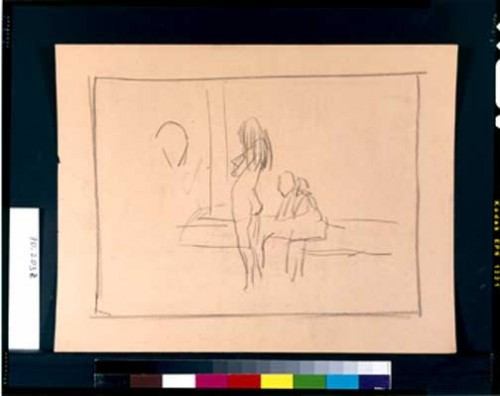
Edward Hopper (American 1882-1967, Study for Morning in a City, 1944, conte crayon on paper, Whitney Museum of American Art, Josephine N. Hopper Bequest
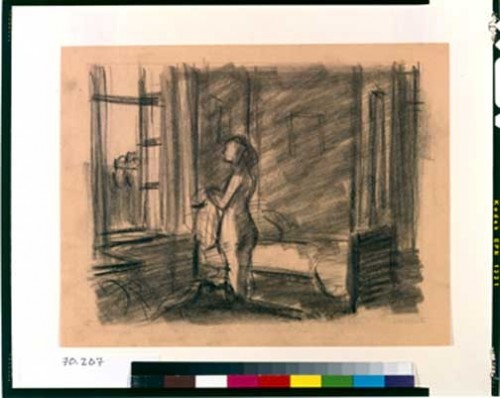
Edward Hopper (American, 1882-1967, Study for Morning in a City, 1944, conte crayon on paper, Whitney Museum of American Art, Josephine N. Hopper Bequest
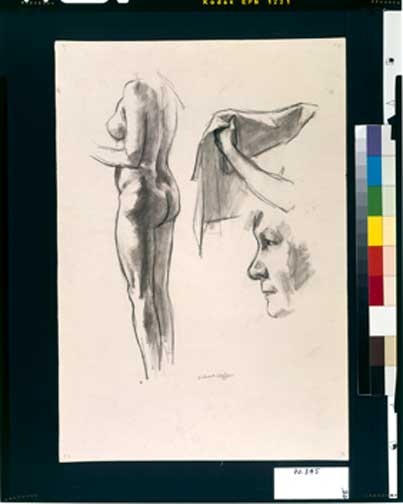
Edward Hopper (American, 1882-1967), Study for Morning in a City, 1944, conte crayon on paper, Whitney Museum of American,

Edward Hopper (American, 1882-1967, Morning in a City, 1944, oil on canvas, 44 5/16 x 59 13/16 inches, Bequest of Lawrence H. Bloedel, Class of 1923 (77.9.7)
Though the slowness and deliberation of Hopper’s creative process—and his relatively small output of oils—has long been noted, it is only through an examination of his drawings that we can understand the gestation of the artist’s ideas and the transformations they underwent from paper to canvas. However, the artist only occasionally exhibited or sold his drawings, retaining most of them for personal reference and using them throughout his career as he developed the lifelong themes and preoccupations of his major oil paintings.
Study for “New York Movie” (1938 or 1939)/Courtesy the Whitney Museum.

Edward Hopper (1882–1967), Study for New York Movie (Palace Theatre), 1938. Fabricated chalk on paper, 8 13/16 × 11 13/16in. (22.4 × 30cm). Whitney Museum of American Art, New York; Josephine N. Hopper Bequest 70.110
,New York Movie (MoMA)
Hopper’s education as an artist was fairly traditional, with intensive early training in drawing— particularly drawing the nude human figure. This included life drawing classes at the New York School of Art, where he studied from 1900 to 1906 with the celebrated exponent of modern American realism, Robert Henri. Early and formative travels to Paris and Europe between 1906 and 1910 produced an important body of work; the exhibition will include recently identified pages from his Paris sketchbooks, featuring lively and acute observations of street life and café culture. Later, in the 1920s, Hopper continued to hone his life drawing skills at the Whitney Studio Club (the precursor to the Museum), near his Greenwich Village studio. These skills served Hopper throughout his career, especially after the early 1930s, when he shifted from painting directly from nature to improvised subjects, deepening his drawing practice as he imagined ideas for his oils.
Edward Hopper Study for Gas, 1940 print
Gas, 1940
The exhibition opens with an overview of Hopper’s drawing career. As a draftsman, Hopper favored black chalk and the rich and subtle tone he was able to achieve with it. This section includes a number of highly finished sheets executed from life, as well as illustrations, portraits, and preparatory studies.

Drawing for Western Motel

Edward Hopper Western Motel
The exhibition continues with seven sections combining paintings with their preparatory studies and related works. One of the most significant of these brings together two of Hopper’s most important canvases, the Whitney’s Early Sunday Morning (1930) and Nighthawks (1942), lent by the Art Institute of Chicago. Nighthawks will, for the first time, be shown with all nineteen of its known drawn studies, including a highly finished sheet recently acquired by the Whitney for its permanent collection. These drawings show the development of every element of this iconic painting, from the massing of its oblique architectural space to the precise arrangements of figures around the nighttime coffee shop’s counter.

Edward Hopper (1882–1967), Study for Manhattan Bridge Loop, 1928. Crayon on paper, 8 1/2 × 11 1/16 in. (21.59 × 28.1 cm). Addison Gallery of American Art, Phillips Academy, Andover, Massachusetts; gift of the artist 1940.71
Edward Hopper Manhattan Bridge Loop, 1928
Shown together, Early Sunday Morning and Nighthawks will emphasize the artist’s interests in New York City’s shifting urban fabric, and the two pieces’ close conceptual relationship to one another as summations of his impressions of urban life. Groundbreaking archival research done in the course of the exhibition’s development has uncovered, for the first time, the precise building on Seventh Avenue on which Early Sunday Morning was based, as well as invaluable historic photographs of the Greenwich Village corners and architecture that inspired Nighthawks—questions that have puzzled historians of Hopper’s work for decades.

EDWARD HOPPER (1882 - 1967)
Study for “Four Lane Road”, c. 1956
Charcoal on paper
8 7/16 x 10 15/16 inches

EDWARD HOPPER Four Lane Road
The exhibition also showcases Hopper’s magisterial 1939 painting New York Movie (lent by the Museum of Modern Art) and the group of fifty-two preparatory studies Hopper made for this work, the largest number of drawings that exist for any painting in his oeuvre. These sheets trace Hopper’s nearly two-month long process of working through the idea for this piece, from his exploratory sketching trips in several Broadway movie palaces to a long and nuanced series of compositional studies for the dark, ornate interior depicted in the work, which he based on the Palace Theatre in Times Square. As with Early Sunday Morning and Nighthawks, photographic documentation of the actual sites that inspired the work will be included in the display.

EDWARD HOPPER, STUDY FOR ROUTE 6, EASTHAM

EDWARD HOPPER, ROUTE 6, EASTHAM
The exhibition will provide similar insight into the creation of many of Hopper’s other celebrated paintings, such as Soir Bleu (1914, Whitney Museum) (BELOW), Manhattan Bridge Loop (1928, Addison Gallery of American Art) (ABOVE) and
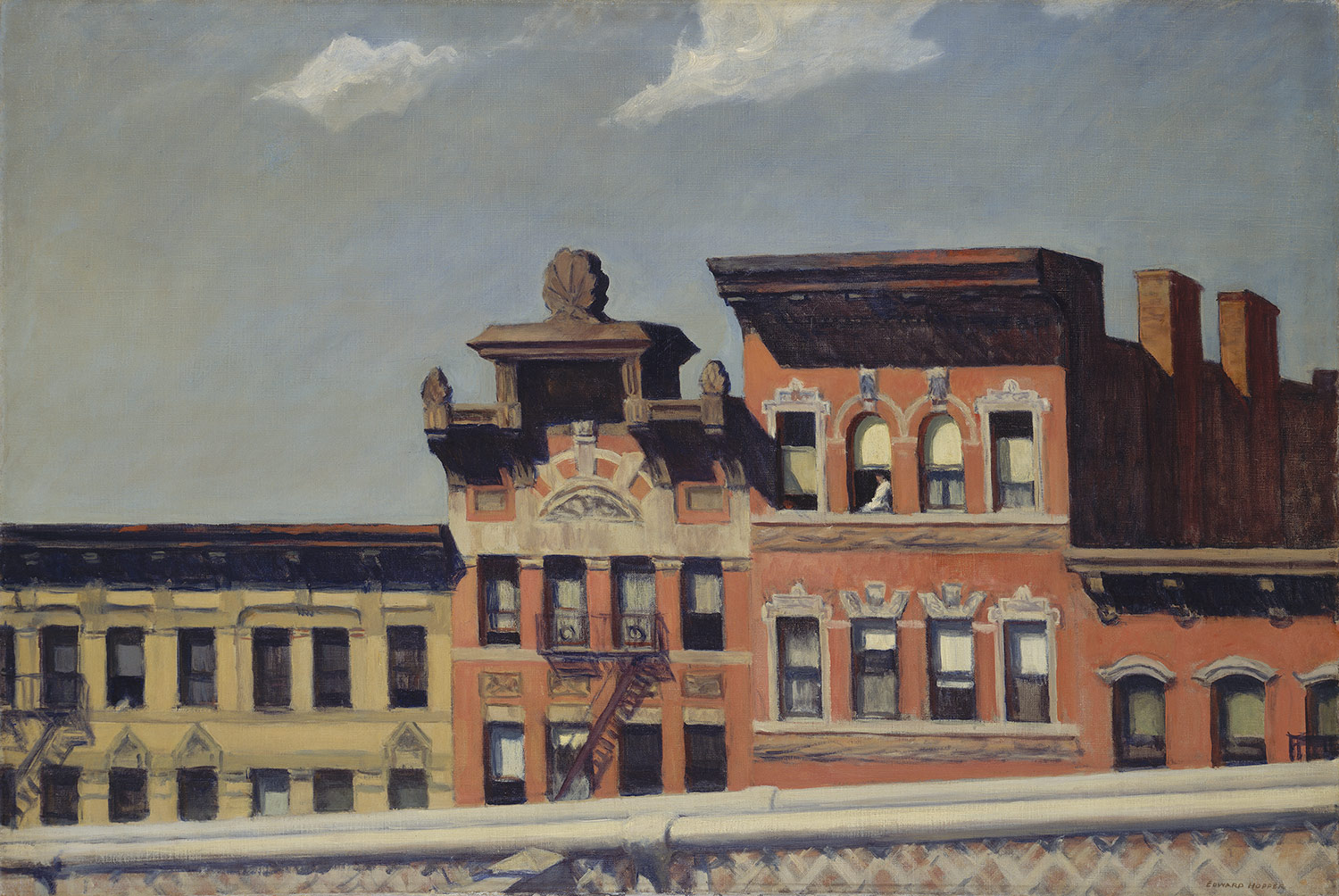
From Williamsburg Bridge (1928, Metropolitan Museum of Art),
Office at Night (1940, Walker Art Center),(ABOVE)

Conference at Night (1949, Wichita Art Museum),
Gas (1940, MoMA),(ABOVE)
Rooms for Tourists (1945, Yale University Art Gallery) and a number of others. These works will be paired and grouped to emphasize the artist’s interest in and revisiting of a relatively narrow set of themes and subjects over the course of his nearly seven-decade-long career.
Edward Hopper: Selected Images (Click on links for interesting audio)
Le Bistro or The Wine Shop, 1909
Soir Bleu 1914
East Side Interior, 1922
Self Portrait, 1925–30
The Sheridan Theater, 1937
Seven A.M.
A Woman in the Sun, 1961
Second Story Sunlight,
Hotel Lobby (Indianapolis Museum of Art),
Hotel Window (from a private collection),
Edward Hopper, Intermission, 1963; Collection SFMOMA, purchase in memory of Elaine McKeon, chair, SFMOMA Board of Trustees (1995–2004), with funds provided in part by the Fisher and Schwab Families; © Heirs of Josephine N. Hopper, licensed by the Whitney Museum of American Art; photo: courtesy Fraenkel Gallery, San Francisco
About the Whitney
The Whitney Museum of American Art is the world’s leading museum of twentieth-century and contemporary art of the United States. Focusing particularly on works by living artists, the Whitney is celebrated for presenting important exhibitions and for its renowned collection, which comprises over 19,000 works by more than 2,900 artists. With a history of exhibiting the most promising and influential artists and provoking intense debate, the Whitney Biennial, the Museum's signature exhibition, has become the most important survey of the state of contemporary art in the United States. In addition to its landmark exhibitions, the Museum is known internationally for events and educational programs of exceptional significance and as a center for research, scholarship, and conservation. Founded by sculptor and arts patron Gertrude Vanderbilt Whitney in 1930, the Whitney was first housed on West 8th Street in Greenwich Village. The Museum relocated in 1954 to West 54th Street and, in 1966, inaugurated its present home, designed by Marcel Breuer, at 945 Madison Avenue on the Upper East Side. While its vibrant program of exhibitions and events continues uptown, the Whitney is constructing a new building, designed by Renzo Piano, in downtown Manhattan. Located at the corner of Gansevoort and Washington Streets in the Meatpacking District, at the southern entrance to the High Line, the new building, which has generated immense momentum and support, will enable the Whitney to vastly increase the size and scope of its exhibition and programming space. Ground was broken on the new building in May 2011, and it is projected to open to the public in 2015.
